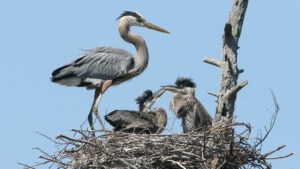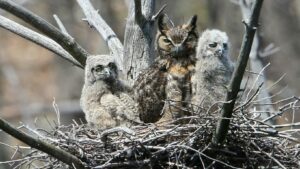
It’s nesting season in our region for year-round birds and returning migrants. But what goes on at a nest? Returning great blue herons (Ardea herodias) offer us a glimpse.
That’s not to say that it’s easy to witness life at a heron’s nest. The swamps and ponds that great blue herons choose are usually fairly inaccessible. But these herons are visible due to size. They’re big birds, about 4 feet tall with a 6-foot wingspan. They make large stick nests, high in dead trees in the middle of a pond or swamp. Nests can be up to 4 feet wide and almost as deep.
Great blue herons nest in colonies with many nests. The herons typically spend much time standing in their nests. They use nests for about four months, mid-March to mid-July. By comparison, if you watch a robin’s nest, the chicks hatch after 2 weeks and are grown and gone after another 2 weeks, soon after you realize they’re there.
What’s to see? First, the herons return in March. Existing nests may need some refurbishing after the winter. As with many other birds, male great blue herons arrive first. They check out nests and claim one or start a new one. They’ll stand in their nests, awaiting females and guarding it from other males. They typically return to the same colony, but not necessarily to the same nest.
Females arrive a week or two later. Pairs form and stand around together at the nest, but they may not be the same two partners as before. Pair bonding involves various courtship activities, which often include one heron, usually the male, flying off and finding a stick to present to the other heron in a “stick dance” display at the nest. Pairs can sometimes be seen interacting and even mating, either at the nest or nearby.
Eventually there’s less standing, as one of the pair sits low in the nest, warming eggs and later young chicks, while the other forages. The two take turns at the nest and can be seen greeting one another and switching off as one returns and the other leaves. Great blue herons don’t sing, but you might hear occasional squawks or see and hear a pair clacking their bills (https://www.allaboutbirds.org/guide/Great_Blue_Heron/sounds).

Chicks become visible in May and June. At first, little beaks appear above the rim of the nest. In the early days, both parents feed the chicks by regurgitating food. There may be 3 or 4 chicks, of somewhat different sizes because eggs are laid two days apart but the parents start incubating with the first egg, so eggs hatch at different times. Chicks in different nests may be at different stages.
The chicks make noise, and as they grow, both parents bring them food, typically fish. The fish are usually large enough for the chicks to share, so sibling competition isn’t usually fierce. Heads appear above the nest, and eventually the young herons can be seen – you guessed it – standing in the nest. They stretch their wings, interact, and later stand on nearby branches.
After two months or so, when the young herons are about the size of their parents and able to fly, they leave the nest. They may not go far, and sometimes return to the nest after foraging with a parent. But all soon becomes quiet in July.
For decades Westborough had a thriving great blue heron colony in Mill Pond, with about 40 nests in the 1990s. This colony disappeared about 15 years ago as the dead trees in the pond gave out. Now we’re lucky to have a relatively a new colony with about eight nests in a swampy area at Hoccomocco Pond. Other colonies are tucked away in wetlands in other towns in our region.
Watch the edges of local ponds and swamps for great blue herons fishing. They do this by – yes, standing around. For such big birds, they’re quite inconspicuous, thanks to the camouflage of their blue-grey coloring and their stillness. They typically fish alone, day or night, by waiting and watching for prey – fish, frogs, crayfish, or any small creature – which they capture with a quick strike or grab with their large bill. Sometimes they walk slowly through the shallows, stalking or possibly stirring up prey. Adults make more successful catches than juveniles, but the youngsters learn with practice.
Other birds sometimes use great blue heron nests. Tree swallows, house sparrows, or grackles might nest among the sticks on the underside of an active nest. In January, long before the herons return, a great horned owl might move into a heron nest and raise a chick or two.
Enjoy our great blue herons, whether you see them at a nest or along a shore. Respect and protect our many ponds and swamps which provide nesting and foraging habitats for them.
***
Nature Notes is written for the Westborough Community Land Trust and re-published online by the Community Advocate.
***
What else might you see outside in nature these days? Check out the WCLT Nature Notes articles listed for these months in our online monthly index.
Did you know that Westborough has 60 miles of trails, and WCLT has trail maps? The Westborough Community Land Trust (WCLT) preserves, protects, and promotes open space in Westborough (westboroughlandtrust.org and facebook.com/westboroughlandtrust).










